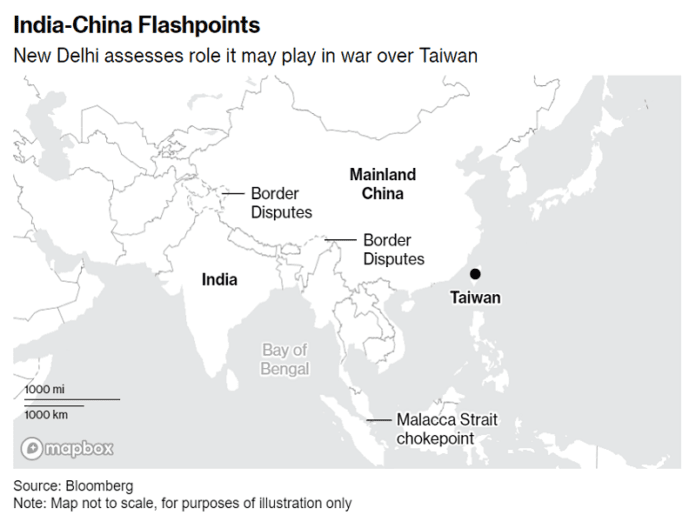Bloomberg published a piece on Friday about how “India’s Military Studying Options for Any China-Taiwan War”, which cites unnamed senior officials from that country to report that its top military commander commissioned a study about this six weeks ago following repeated US requests. It was released on the eve of this year’s G20 Summit in Delhi that President Xi declined to participate in without explanation but was likely due to rising Sino-Indo tensions as argued in this analysis here.
According to this leading Western outlet, “One option the Indian military will study involves serving as a logistics hub to provide repair and maintenance facilities for allied warships and aircraft, as well as food, fuel and medical equipment for armies resisting China, the officials said. A more extreme scenario, they added, would assess the potential for India to get directly involved along their northern border, opening a new theater of war for China.”
They also shared insight from “Lisa Curtis, senior fellow and director of the Indo-Pacific Security Program at the Washington-based Centre for a New American Security, who earlier worked with the National Security Council, CIA and the State Department. It’s possible India may provide access to places like the Andaman and Nicobar Islands near Southeast Asia, she added.” The previously mentioned first option coupled with her forecast reflect the most realistic response that India might employ in that scenario.
The following five background briefings will help readers understand the preceding assessment:
* 1 May: “Foreign Affairs Published An Impressively Insightful Analysis About Indian-US Relations”
* 4 May: “RIC’s Differences Should Be Candidly Acknowledged Instead Of Denied Or Spun By Alt-Media”
* 22 June: “The US Finally Realized The Futility Of Trying To Force India Into Vassalhood”
* 23 June: “Russia Expressed Confidence That INDUS-X Won’t Rope India Into Any American Alliances”
* 29 June: “India Should Be Wary Of The US Encouraging It To Get More Involved In The South China Sea”
The rest of the analysis will incorporate the above insight to explain why Curtis’ prediction is accurate.
The US’ liberal–globalist policymaking faction finally lost out to their comparatively more pragmatic rivals in directing American policy towards India, and while the former is still actively attempting to subvert the latter as detailed here, the overall trend of bilateral relations is one of increasing equality and respect. Accordingly, those pragmatic figures that are presently in charge acknowledge the unlikelihood of India going to war against China at their behest, be it in the Himalayas or especially in the South China Sea.
Nevertheless, it’s not in India’s interests to have China obtain control over Taiwan’s superconductor industry, hence why it’s expected to offer indirect and non-military support for those of its partners who might play a leading role in supporting Taipei should any theoretical conflict become protracted. This strategic imperative lends credence to Curtis’ prediction that India would allow the US logistical access to the Andaman and Nicobar Islands in accordance with their newly clinched INDUS-X agreement.
Not only is that union territory conveniently located near the Strait of Malacca, but being physically disconnected from the Indian mainland reduces the chances that China might consider escalating along the Himalayas in response to Delhi providing such logistical support to the US. That said, Southeast Asian supply facilities would be more useful in all respects, so it might ultimately be the case that India doesn’t even play a direct role in any Taiwanese Conflict even if it goes on for a while like the Ukrainian one.








